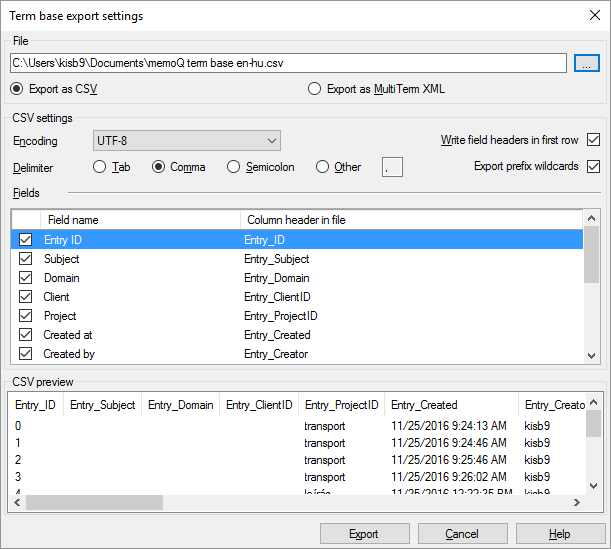|
You can export the contents of term base contents into tabular text files - CSV or tab-separated files - or into MultiTerm XML files. MultiTerm XML files can be used in SDL Trados Multiterm. In the Term base export settings window, you can choose the folder and the file name, the format, and the fields that go into the exported file. How to get here1.Open a project. In Project home, choose Term bases. From the Resource console: Open the Resource console. Choose Term bases. From an online project: As a project manager, you can open an online project for management. In the memoQ online project window, choose Term bases. 2.Right-click the name of the term base you need to export. From the menu, choose Export Terminology. The Term base export settings window opens.
What can you do?1.Choose a folder and a name: Under File, click the ellipsis button 2.Choose a format: ▪To export a tabular text file, click Export as CSV. ▪To export a MultiTerm XML file, click Export as MultiTerm XML. Custom matching characters are not exported to MultiTerm XML: When you use custom matching in a term base entry, the terms may contain asterisks (*) or pipe characters (|). memoQ does not export these in MultiTerm XML because SDL Trados MultiTerm does not support custom matching this way. The extra characters would appear in terms in MultiTerm. No more settings for MultiTerm XML: If you choose MultiTerm XML, all settings disappear. You can export the file immediately. If you export a CSV file, you need to choose a delimiter and an encoding, and choose which fields should be exported: 3.In the Encoding drop-down box, choose an encoding. The most versatile setting is UTF-8. Normally, memoQ uses this. It's a variant of Unicode that minimizes the size of the file. It is not recommended to choose anything else. Except if the term base contains terms in Asian languages: In that case, you may need to choose one of the Unicode settings. 4.Under Delimiter, choose the character that will separate the columns (cells) from each others. Click Tab or Comma or Semicolon or Other. If you click Other, type exactly one character in the box next to it. 5.Normally, memoQ writes column headers at the top of the file. Do not turn this off: Make sure the Write field headers in first row check box is always checked. 6.If the exported file will be used in a different translation tool, clear the Export prefix wildcards check box. If the exported file will be opened in another program that is not a translation tool, keep the check box checked. 7.Under Fields, check the check box for each field that you want to export. If you do not want to export a field, clear its check box. Keep an eye on the CSV preview: While you are setting up the export, watch the CSV preview box. memoQ always shows what the exported file will look like. Always check if the characters appear as they should and the columns you need are there. When you finishTo export the term base, and return to Project home or to the Resource console: Click Export. To return to Project home or to the Resource console: Click Cancel. |
